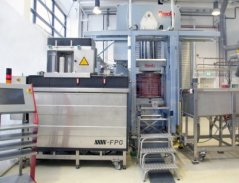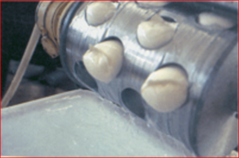Onderwerp scriptie
Process innovation
Topic 1. Exploring the effect of Pulsed Electric Field (PEF) cooking on nutritional and sensory properties of food.
Pulsed Electric Field (PEF) is a relatively new mild technology for food processing. In PEF, foods are subjected to an electric field with high field strength which causes damages to cell membranes (electroporation). The result is the inactivation of bacteria and pasteurization/sterilization of food samples with relatively low temperatures. So far PEF technology has been mainly used as a non-thermal food preservation method. Compared with traditional thermal pasteurization, it provides a better preservation of the original sensorial properties (taste, colour, texture), but also of nutrients and heat labile health-promoting functional components of foods (Soliva-Fortuny et al., 2009). Whereas PEF has been long tested for food pasteurization and sterilization, PEF based cooking is an entirely new topic. It is predicted that this technology can be used to cook food in a faster way which would considerably reduce energy besides the obvious advantage of reducing losses in nutrients and sensorial quality. PEF is also known to improve extractability of intracellular compounds from food matrices. Therefore, it can also improve the bio-accessibility of several health promoting compounds.
Aim
The aim of the present study is to assess the impact of PEF-cooking on nutritional and sensorial attributes of selected food preparations.
ApproachThis study will be carried out in collaboration with Food Biobased Research (FBR). We will use an ad hoc developed table top Pulsed Electric Field (PEF) cooking units. This equipment is based on proprietary technology owned by a private company. The impact on healthy properties of cooked foods will be investigated under varying operating conditions (different electric field strength and/or number of pulses). Examples of nutritional relevant attributes to investigate are: retention and bio-accessibility of vitamins/phytochemicals, and starch digestibility. To test the impact on bio-accessibility and starch hydrolysis the standardised static in vitro digestion method proposed by the COST INFOGEST network (Minekus et al. 2014) will be used. Sensory analyses will be carried out to assess the effect on taste, flavour, texture and appearance of PEF-cooked food.
Some referencesFincan, M., DeVito, F., & Dejmek, P. (2004). Pulsed electric field treatment for solid-liquid extraction of red beetroot pigment. Journal of Food Engineering, 64, 381-388.
Minekus, M., et al., 2014. A standardised static in vitro digestion method suitable for food – an international consensus. Food and Function, 5, 1113-1124.
Soliva-Fortuny, R, Balasa, A, Knorr, D., & Martin-Belloso, O. (2009). Effects of pulsed electric fields on bioactive compounds in foods: a review. Trends in Food Science & Technology, 20, 544-556.
For more information please contact Edoardo Capuano.
Topic 2. Novel processing of high quality tomato product.
Novel processing techniques, like high pressure processing and pulsed electric field treatment are used to preserve food products. These techniques are alternatives to thermal heat preservation, with minimal changes in sensorial an nutritional properties of the food, without compromising on the food safety and shelf life of the products.
More and more products pasteurized with these novel processing techniques are introduced to the market. Furthermore, high pressure sterilization becomes more and more an interesting topic to study on pilot scale.
A thesis topic can be to study the influence of high pressure processing on high quality tomato products. We would like to see what happens with the quality of tomato products when varying processing conditions or changes in the composition of the tomato products are made.
The study will start with a literature overview on tomato products produced with varying (novel) processing techniques. Subsequently or parallel, high pressure experiments with tomato products will be carried out on the lab scale and pilot scale high pressure unit of Food & Biobased Research. Variable processing conditions can be used and quality of the produced products will be evaluated (i.e. appearance, texture, shelf life, enzyme activity and sensorial aspects). Dependent on results, alternations on product composition can be made to optimize for a high quality tomato product.

For more information please contact Rian Timmermans.
Topic 3. Developing of a simplified model system to investigate the efficacy of preservatives and acidification agents in cream and processed cheese.
The scope of this research is the development of model systems for fresh, processed cheese, in order to simplify the complex cheese systems and study of the effect of natural preservatives on microbial growth, texture and flavour in cheese. These model systems need to mimic the textural characteristics and taste of a normal cheese and should qualify for all the analyses. The systems will be used in order to screen the efficacy of different antimicrobials and acidification agents.
Question 1: Can a laboratory scale model system mimic the behavior of fresh and processed cheese during processing and shelf life
Question 2: Which is the impact of different acidification agents on the quality of the final product (firmness, spreadability, flavour profile
Question 3: How the different chemical nature of the starting material (fresh, UHT or reconstituted milk) influenced the final characteristic of the product
Proposed approach
The work will be performed in close collaboration with Corbion which is a main producer of preservation and coagulation agents for cheese industry. Different formulation strategies will be employed combined with chemical and physical analysis to assess the quality during the process in the different model system. Kinetic modelling to foresee the behavior of the models will be also employed.
References
Bachmann H [et al.] A High-Throughput Cheese Manufacturing Model for Effective Cheese Starter Cultrure Screening Journal of Dairy Science. - 2009. - pp. 5868–5882
Fox P.F [et al.] Cheese: Chemistry, Physics and Microbiology [Book]. - Oxford : Elsevier Ltd, 2004. - 3rd : Vol. 1.
Fox P.F [et al.] Cheese: Chemistry, Physics and Microbiology [Book]. - Oxford : Elsevier Ltd, 2004. - 3rd : Vol. 2.
For more information please contact Vincenzo Fogliano.